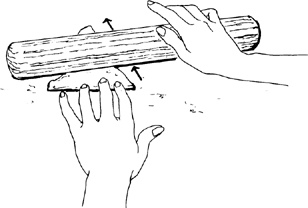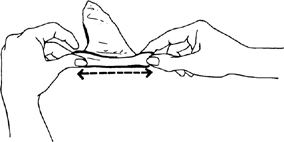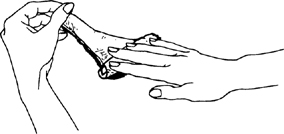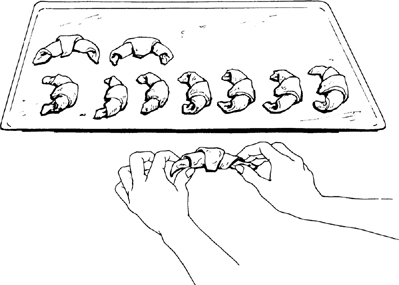Mastering the Art of French Cooking, Volume 2 (47 page)
Read Mastering the Art of French Cooking, Volume 2 Online
Authors: Julia Child

TURNING TRIANGLES INTO CRESCENTS OR CROISSANTS Holding one of the triangles of dough by its large end, roll it out toward the point to make the triangle about 7 inches long |
|
| Then, to extend the large end slightly, |
Start rolling up the croissant first by folding the large end forward onto itself |
|
Bend the 2 ends down to form a crescent shape and place on a lightly buttered baking sheet, with point resting inside curve and against surface of baking sheet
. Form the rest of the triangles into croissants in the same manner.
(*)
DELAYED ACTION
: Formed croissants may be wrapped airtight and frozen for a week, if dough was not frozen before.
6)
Final rise—about 1½ hours at 75 degrees
Cover
croissants loosely with a large sheet of plastic and set at a temperature of around 75 degrees for their final pre-baking rise. Dough should almost triple in size and feel light and springy when touched; if it does not rise and feel light, the baked croissants will be heavy and hard rather than tender, puffy, and light. In hot weather you may have to set dough in refrigerator from time to time to prevent butter from softening and oozing out.
(*)
DELAYED ACTION
: For a slower rise, set dough in a colder place or refrigerate; if thoroughly chilled, leave at room temperature 20 to 30 minutes before baking. Risen croissants may be frozen for a few days and baked in their frozen state.
7)
Glazing, baking, and storing—oven preheated to 475 degrees
A pastry brush
1 egg beaten with 1 tsp water in a small bowl
A cake rack
Just before baking, paint the croissants with egg glaze, then set in middle level of preheated oven for 12 to 15 minutes, until croissants are nicely puffed and brown. Cool on a rack for 10 to 15 minutes before serving.
Croissants are at their best when freshly baked; even refrigerated in an airtight container, they are never as good the next day. Freezing is the best preservation: wrap airtight when croissants are thoroughly cool and freeze. To thaw and serve, set frozen croissants on a lightly buttered baking sheet and place in a preheated 400-degree oven for 5 minutes.
PASTRY DOUGHS
Pastry doughs, both tart and pie doughs and puff pastry, play an immensely important part in every phase of French cooking from little hot appetizers to
quiches
, and from
pâtés en croûte
to strawberry tarts,
mille-feuilles
, and
Pithiviers
. If pie dough has always been your culinary bugaboo, remember that no one is born a pastry chef, everyone has had to learn, and that the first big step is to make the decision that you are now, today, going to learn to make a decent pie crust. Then make pie dough every day or two for a week or more; serve everything you can think of in pastry. You will be surprised how quickly you develop the technique, and you will then be in the masterful position of having an endless number of delicious concoctions at your fingertips. All the recipes here are for at least 1 pound of flour. Our feeling is that if you are going to make dough at all you might as well make a lot, because it keeps beautifully in the freezer.






